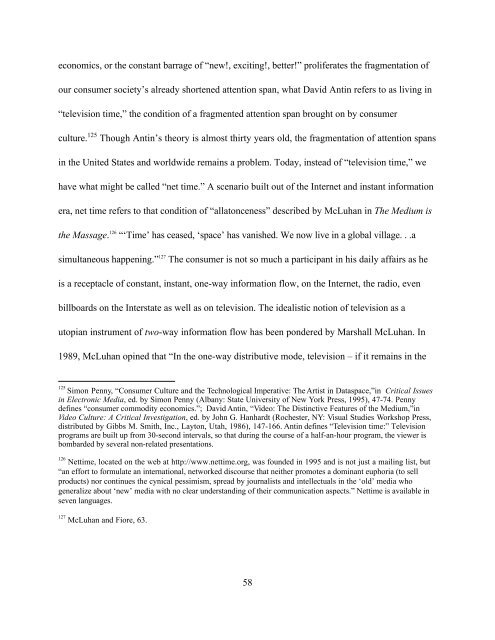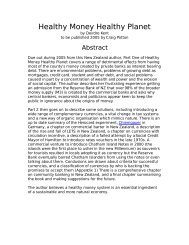THE YES MEN AND ACTIVISM IN THE INFORMATION ... - Index of
THE YES MEN AND ACTIVISM IN THE INFORMATION ... - Index of
THE YES MEN AND ACTIVISM IN THE INFORMATION ... - Index of
Create successful ePaper yourself
Turn your PDF publications into a flip-book with our unique Google optimized e-Paper software.
economics, or the constant barrage <strong>of</strong> “new!, exciting!, better!” proliferates the fragmentation <strong>of</strong><br />
our consumer society’s already shortened attention span, what David Antin refers to as living in<br />
“television time,” the condition <strong>of</strong> a fragmented attention span brought on by consumer<br />
culture. 125 Though Antin’s theory is almost thirty years old, the fragmentation <strong>of</strong> attention spans<br />
in the United States and worldwide remains a problem. Today, instead <strong>of</strong> “television time,” we<br />
have what might be called “net time.” A scenario built out <strong>of</strong> the Internet and instant information<br />
era, net time refers to that condition <strong>of</strong> “allatonceness” described by McLuhan in The Medium is<br />
the Massage. 126 “‘Time’ has ceased, ‘space’ has vanished. We now live in a global village. . .a<br />
simultaneous happening.” 127 The consumer is not so much a participant in his daily affairs as he<br />
is a receptacle <strong>of</strong> constant, instant, one-way information flow, on the Internet, the radio, even<br />
billboards on the Interstate as well as on television. The idealistic notion <strong>of</strong> television as a<br />
utopian instrument <strong>of</strong> two-way information flow has been pondered by Marshall McLuhan. In<br />
1989, McLuhan opined that “In the one-way distributive mode, television – if it remains in the<br />
125 Simon Penny, “Consumer Culture and the Technological Imperative: The Artist in Dataspace,”in Critical Issues<br />
in Electronic Media, ed. by Simon Penny (Albany: State University <strong>of</strong> New York Press, 1995), 47-74. Penny<br />
defines “consumer commodity economics.”; David Antin, “Video: The Distinctive Features <strong>of</strong> the Medium,”in<br />
Video Culture: A Critical Investigation, ed. by John G. Hanhardt (Rochester, NY: Visual Studies Workshop Press,<br />
distributed by Gibbs M. Smith, Inc., Layton, Utah, 1986), 147-166. Antin defines “Television time:” Television<br />
programs are built up from 30-second intervals, so that during the course <strong>of</strong> a half-an-hour program, the viewer is<br />
bombarded by several non-related presentations.<br />
126 Nettime, located on the web at http://www.nettime.org, was founded in 1995 and is not just a mailing list, but<br />
“an effort to formulate an international, networked discourse that neither promotes a dominant euphoria (to sell<br />
products) nor continues the cynical pessimism, spread by journalists and intellectuals in the ‘old’ media who<br />
generalize about ‘new’ media with no clear understanding <strong>of</strong> their communication aspects.” Nettime is available in<br />
seven languages.<br />
127 McLuhan and Fiore, 63.<br />
58














